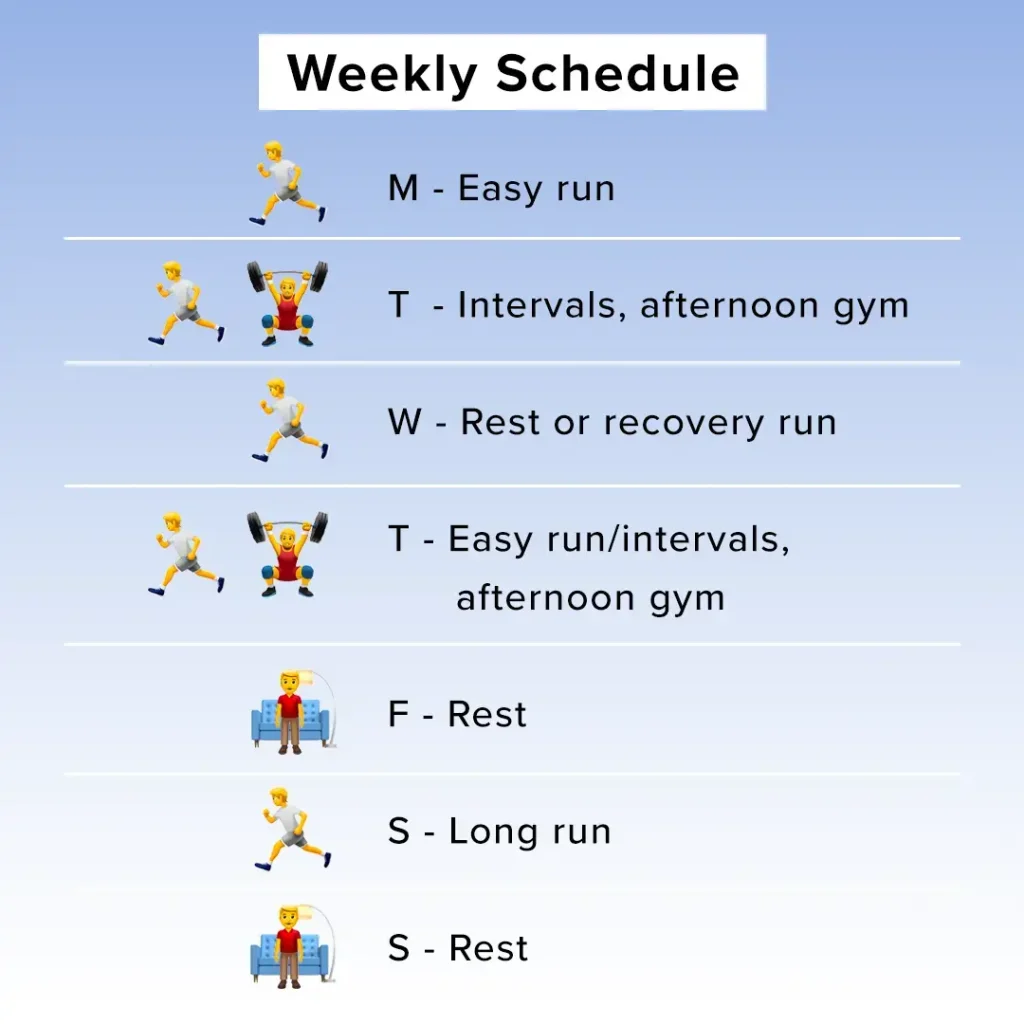Yes, Runners, You Should Be Lifting Weights and Training Strength, Too
Fast Facts
- Research shows weight training can increase runners’ performance by improving running economy speed
- Professionals believe strength training also helps runners build resilience, avoid injury, and recover faster
- Strength training for running can incorporate a wide range of exercises and encompass as few as two 25-minute sessions per week
There’s a longstanding belief among weight lifters and distance runners that the two practices are diametrically opposed, incompatible. At a glance, it might seem to be true, too—take a look at the front pack of any major marathon and you’ll notice that all of the runners there are slender and lithe, not bulked up. Look closer though, and you’ll see that they’re undeniably strong, too, and it’s little surprise that greats like Eliud Kipchoge and Hellen Obiriwho spend so much of their waking hours clocking miles also make time in their training schedules to hit the gym.
Still, the fear that weight and resistance training is counterproductive to running performance because it increases body mass—i.e. you get stronger, you get heavier, you get slower—pervades. (And, many runners you ask will tell you that they just don’t like weight training.) That worry might be warranted, but there’s plenty of proof that, with the right approach, resistance training can be a performance-boosting part of a runner’s weekly routine.
Why Is Strength Training Important for Runners?
First, some evidence. Exhibit 1: A seminal 1988 study (that’s been cited by more than 500 studies since publishing) found “a complete lack of any negative physiological effects of adding strength training to a regular program of endurance exercise in well-trained subjects. In fact, the performance results generally show a positive effect on short-term endurance and on long-term endurance to some extent,” (1). Exhibit 2: A 2013 study published in the Journal of Strength and Conditioning Research that found that combining running and both explosive and endurance strength training “led to improved maximal strength, running economy, and peak velocity with no significant effects on the VO2 kinetics pattern” (2) among a group of elite male runners.
We could go on to exhibit three, four, five, six, and on and on, but the general scientific consensus is clear that at best, supplemental strength training can aid runners and, at worst, it can’t do them any harm. But most of these studies are finely targeted and their results highly specific; put into holistic practice (as in, a real training program), gym time can give runners a few extra edges, even if a speedy new PR isn’t one of them.
“From a performance standpoint, we want to try and stay healthy as long as we can throughout the season,” says Andrew Kastor, head coach of the ASICS Mammoth Track Club, who advocates runners incorporate strength training for a number of reasons. One that he notes is that we’re a little off balance. “I believe that strength training finds the muscle weaknesses and gets those strong and helps balance out the body bilaterally.” Improving muscle motor recruitment and strengthening ligaments, tendons, and muscle tissue are additional benefits he lists. (Three separate physical therapists have prescribed strength training to this marathon-running writer for all of these reasons.)
Kastor also lists a fourth reason for assigning gym sessions to his runners: it helps with recovery. “When you stimulate large muscle groups, your body produces human growth hormone and that gets flooded out through the whole body,” he explains. “That goes and helps repair and recover all the muscle tissue that’s broken down during running too.”
Summary
- Research suggests running is, at worst, a net neutral for running performance (but probably beneficial in a number of ways)
- Strength training teaches the body to recruit more muscles, resulting in better balance over time
- Strength training helps facilitate recovery from longer runs

What Does Strength Training for Runners Look Like?
Heavy weights for low reps and light weights for high reps can work
The key to unlocking any of the benefits of strength training for running is to lift correctly. In a recent YouTube interview (3) with Rhonda Patrick, Brad Schoenfeld, widely considered to be the godfather of muscle-building research, recommends runners doing cross country, marathons, or any type of long distance training to incorporate minimalist, low-volume weight lifting into their routines. Instead of light loads and high volumes, he says go heavy and go low. “If you’re doing low-volume training with heavy loads, then generally speaking you’re not going to gain much weight in terms of muscle mass but you will be able to get the benefits that will help you optimize your endurance capacity.”
Most scientific studies on the subject tend to agree, and so does Kastor, with one big caveat for everyday runners. “I think the higher the weight, the higher risk of injury if instruction isn’t given,” he says. “I think people can watch a YouTube video about lunges and kind of nail it, as long as they’re smart with their weight and volume progression. You really need an instructor to teach proper squatting, and squats are valuable.” Again, the first priority is staying healthy.
Kastor also notes that, scientific evidence aside, real-world race results allow for some flexibility in approach. Olympic multi-medalist and world champion Mo Farah subscribes to the low-rep philosophy while Eliud Kipchoge, the only man to run a sub-two-hour marathon, does a longer, body weight-only routine with some stretching at the end.
This variance should be encouraging. “There were guys running back in the ’80s just as fast as guys are running now and they were doing a completely different weight training routine,” Kastor says. Typically, he advocates for a blend of exercises that evolves as a runner gets more conditioned to the workouts.
Start slowly and build up strength over time
Like it is with ramping up your running to longer distances, incorporating weight training into your routine should be done gradually. “Easing into it is super important,” says Ryan Hall, the now-retired holder of the American men’s half marathon record on an episode of the Extramilest Show. During the first week of weight training, he recommends stopping each set at what feels like 10 reps before failure and building from there. He also advises runners to begin their strength training journey by working with a coach or lifting with other runners to get a grasp on proper form.
Kastor advises a similar tact: “Maybe it’s high reps low weight for a period of time and then that blends into decreasing volume, increasing the intensity, and now we’re talking about our four-rep sets.”
It should be noted that this advice is typical for anyone new to weightlifting—not just runners entering the weightroom for the first time. If you’re unfamiliar with a movement, start lighter to get the form down before loading up on weight and risking injury.
And, if you are training for a race, make sure to taper back the weight training alongside the running in the final lead-in to the event.
Stay consistent, but flexible with routine
Even runners at the highest level agree that a supplemental strength routine doesn’t have to be strict, and actually, it shouldn’t be. Kastor illustrates this by describing what a strength and conditioning coach assigned his wife Deena—as in Deena Kastor, Olympic bronze medalist and former holder of the American marathon record—in the lead up to the 2004 Athens games.
“He tore a piece of paper into squares, and he wrote down about 12 exercises and the amount, the volume, and he folded those papers up and he put them in a shoebox and every time Deena went to the gym she’d have to shake up the shoebox, reach in, and pull out the workout. That’s how nonspecific it was.”
Hall, who since retiring from professional running has taken up serious weightlifting alongside coaching, similarly emphasizes a loose approach. He advises runners to start with exercises they enjoy doing, to try to make gym time fun. “The way to be consistent is to love your training,” he says. Consistency over long periods of time is key—in both running and lifting.
Summary
- Heavy weights and lower rep counts AND lower weights with higher rep counts can both work
- The beginning of your strength training journey should be focused on perfecting form rather than pushing heavy weights
- Consistency is what determines how much benefit you stand to gain from weight training
When to Train Strength & How Often
For non-professional runners who balance their training with work, family, and other hobbies, finding any time for strength sessions might be more important than trying to arrange them perfectly throughout the week. Kastor recommends two 25-30-minute blocks per week. Ideally, in the afternoon, six or seven hours after doing a harder run workout, and not on the same day as a long run. If you have to do it on the same day as an easy run that’s fine, he says, but notes that those days are made for recovery from the harder efforts of speed days, not extra work.
Those with the urge to do as much as possible (a compulsion that afflicts many runners) can be assured that even the elites don’t do much more than this. David Kilgore, On Running’s global athlete manager and a long distance runner who recently won seven marathons on seven continents over seven consecutive days, says that he keeps his strength training to once or twice a week. Before Hall retired, he did leg-focused weight training two times a week, plus core exercises five days a week. Kastor’s team of elites hit the gym three times a week; two sessions for general resistance training with a third dedicated to core.
Example of a weekly schedule
The above is just one way to set up a week of running and weightlifting for an everyday runner doing four or five runs per week including one or two speed workouts and one long run. It follows the general rules described above, which should serve as the ultimate guidelines for adjusting the routine to whatever schedule works best for you.
For comparison, here’s Kilgore’s typical week:
“A standard week is probably three to four easy type runs lasting 45 minutes to one hour in length with short pickups at the end, two days of fartleks encompassing 60-75 minutes of running, one longer run per week of 90-minute-plus with some pickups during, and usually one or two double days with another 20-40 minute run on the fartlek or long run days. I usually will also add in my strength on the long run or fartlek days.”
And here’s what Kastor’s elites at Mammoth Track Club do:
“They train twice a day, four to five times a week. So they’re doing 10 to 12 running training sessions a week. They go to the gym three times a week, typically Tuesday and Friday, and then they have a core routine that they do on Sundays [that] they can kind of slide around a little bit to meet their energy levels or their travel schedule; if they’re racing, they can move it to a Wednesday or a Saturday. Our [speed] workout days are Tuesday morning and Friday morning, and then our long run is Sundays.”

Best Strength Exercises for Runners
There are many, many ways runners can use their time in the gym. Rather than overwhelming, this should be reassuring—it means that even a minimal home gym setup can be sufficient for an elite-grade program if that’s all you have. And remember, a loose program will still do the trick. Here are a few to start with.
Walking lunges
“The lunge is probably the most important single leg exercise that a runner can do because it’s going to target all the little stabilizer muscles in the hip, all the tendons that act upon the knee to stabilize the knee, even ankle stabilizers,” says Kastor. He recommends doing four lengths of 10-12 meters. Hold weight after the first few weeks and increase to build progression.
Romanian Deadlift (RDL)
Kilgore lists RDLs in his grab bag of strength movements, and Kastor recommends them too. RDLs target posterior chain muscles like the glutes, hamstrings, calves, lats, and erector spinae, which are all important for running. Since RDLs use weights, focus on correct form first, then progression. Single-leg RDLs with a dumbbell or kettlebell are a good variation that will help balance by targeting stabilizer muscles.
Running Arms
Kastor bills this one as providing good bang for buck. With five or 10-pound dumbbells in each hand, feet shoulder width apart and knees slightly bent, core engaged, elbows at 90 degrees, pump your arms forward and backward as you do when you run for 30 seconds, minimizing shoulder oscillation — that’s one rep. “It’s getting a little resistance to the bones in the arm but it’s also a really good core exercise for the transverse abdominis all the way down to the hips. That’s really what our arms are meant to do during running, is counteract the torque that the legs [produce].”
Squats
Squats are a full-body exercise that target all the stride-powering muscle groups runners use to propel themselves, plus the core, and can help with joint resilience and flexibility. Runners new to squats should have an instructor (or knowledgeable friend) teach them proper form, and start with bodyweight before getting under the bar. There are lots of squat variations that runners can experiment with to find out what works best for them, too.
Push-Ups (or Bench Press)
It might surprise runners to see an upper body-only exercise on the recommended list. But push-ups have benefits in that you can do them anywhere, and they target major muscle groups in the arms and core that are necessary for good and proper running form. They can also help stimulate the production of HGH.
Other Options
Kilgore also incorporates cleans, fire hydrants, calf raises, crunches, planks, and dynamic stretches into his weight routine, and there are many more strength exercises ideal for running that you can find through brief online search.
The Bottom Line
If you’re looking to run faster and further, you should be doing some strength training. It can help you recover faster, make you quicker, improve your running economy, and every elite runner is doing some form of it.













